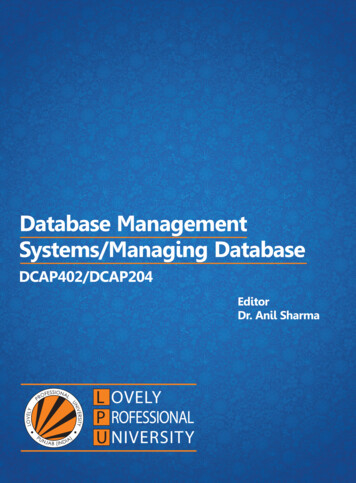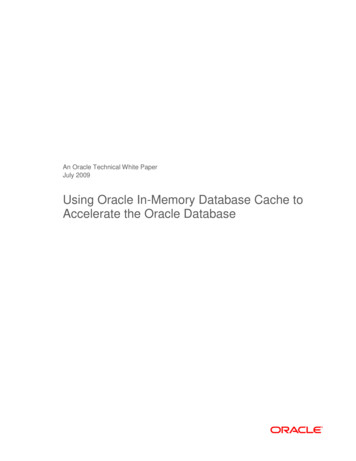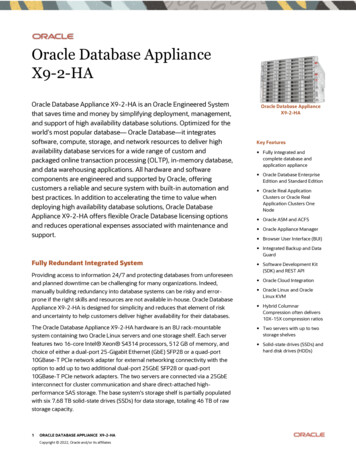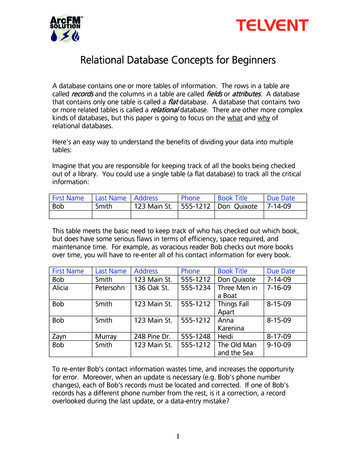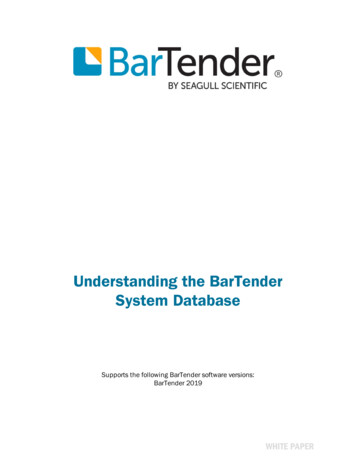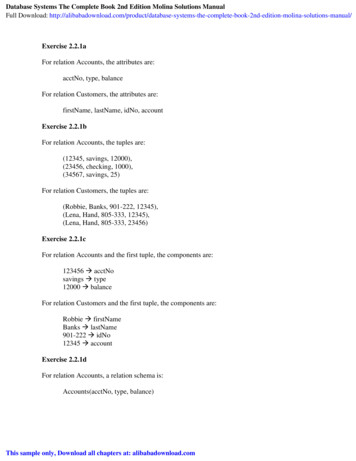
Transcription
Database Systems The Complete Book 2nd Edition Molina Solutions ManualFull Download: anual/Exercise 2.2.1aFor relation Accounts, the attributes are:acctNo, type, balanceFor relation Customers, the attributes are:firstName, lastName, idNo, accountExercise 2.2.1bFor relation Accounts, the tuples are:(12345, savings, 12000),(23456, checking, 1000),(34567, savings, 25)For relation Customers, the tuples are:(Robbie, Banks, 901-222, 12345),(Lena, Hand, 805-333, 12345),(Lena, Hand, 805-333, 23456)Exercise 2.2.1cFor relation Accounts and the first tuple, the components are:123456 acctNosavings type12000 balanceFor relation Customers and the first tuple, the components are:Robbie firstNameBanks lastName901-222 idNo12345 accountExercise 2.2.1dFor relation Accounts, a relation schema is:Accounts(acctNo, type, balance)This sample only, Download all chapters at: alibabadownload.com
For relation Customers, a relation schema is:Customers(firstName, lastName, idNo, account)Exercise 2.2.1eAn example database schema is:Accounts (acctNo,type,balance)Customers (firstName,lastName,idNo,account)Exercise 2.2.1fA suitable domain for each attribute:acctNo Integertype Stringbalance IntegerfirstName StringlastName StringidNo String (because there is a hyphen we cannot use Integer)account IntegerExercise 2.2.1gAnother equivalent way to present the Account pesavingscheckingsavings
Another equivalent way to present the Customers Exercise 2.2.2Examples of attributes that are created for primarily serving as keys in a relation:Universal Product Code (UPC) used widely in United States and Canada to track products instores.Serial Numbers on a wide variety of products to allow the manufacturer to individually trackeach product.Vehicle Identification Numbers (VIN), a unique serial number used by the automotive industryto identify vehicles.Exercise 2.2.3aWe can order the three tuples in any of 3! 6 ways. Also, the columns can be ordered in any of3! 6 ways. Thus, the number of presentations is 6*6 36.Exercise 2.2.3bWe can order the three tuples in any of 5! 120 ways. Also, the columns can be ordered in anyof 4! 24 ways. Thus, the number of presentations is 120*24 2880Exercise 2.2.3cWe can order the three tuples in any of m! ways. Also, the columns can be ordered in any of n!ways. Thus, the number of presentations is n!m!Exercise 2.3.1aCREATE TABLE Product (maker CHAR(30),model CHAR(10) PRIMARY KEY,type CHAR(15));Exercise 2.3.1bCREATE TABLE PC (
model CHAR(30),speed DECIMAL(4,2),ram INTEGER,hd INTEGER,price DECIMAL(7,2));Exercise 2.3.1cCREATE TABLE Laptop (model CHAR(30),speed DECIMAL(4,2),ram INTEGER,hd INTEGER,screen DECIMAL(3,1),price DECIMAL(7,2));Exercise 2.3.1dCREATE TABLE Printer (model CHAR(30),color BOOLEAN,type CHAR (10),price DECIMAL(7,2));Exercise 2.3.1eALTER TABLE Printer DROP color;Exercise 2.3.1fALTER TABLE Laptop ADD od CHAR (10) DEFAULT ‘none’;Exercise 2.3.2aCREATE TABLE Classes (class CHAR(20),type CHAR(5),country CHAR(20),numGuns INTEGER,bore DECIMAL(3,1),displacement INTEGER);
Exercise 2.3.2bCREATE TABLE Ships (name CHAR(30),class CHAR(20),launched INTEGER);Exercise 2.3.2cCREATE TABLE Battles (name CHAR(30),date DATE);Exercise 2.3.2dCREATE TABLE Outcomes (ship CHAR(30),battle CHAR(30),result CHAR(10));Exercise 2.3.2eALTER TABLE Classes DROP bore;Exercise 2.3.2fALTER TABLE Ships ADD yard CHAR(30);Exercise 2.4.1aR1 : σspeed 3.00 (PC)R2 : πmodel(R1)model100510061013Exercise 2.4.1bR1 : σhd 100 (Laptop)R2 : Product(R1)R3 : πmaker (R2)
makerEABFGExercise 2.4.1cR1 : σmaker B (ProductR2 : σmaker B (ProductR3 : σmaker B (ProductR4 : πmodel,price (R1)R5 : πmodel,price (R2)R6: πmodel,price (R3)R7 : R4 R5 3010491429Exercise 2.4.1dR1 : σcolor true AND type laser (Printer)R2 : πmodel (R1)model30033007Exercise 2.4.1eR1 : σtype laptop (Product)R2 : σtype PC(Product)R3 : πmaker(R1)R4 : πmaker(R2)R5 : R3 – R4makerFGExercise 2.4.1f
R1 : ρPC1(PC)R2 : ρPC2(PC)R3 : R1(PC1.hd PC2.hd AND PC1.model PC2.model) R2R4 : πhd(R3)hd25080160Exercise 2.4.1gR1 : ρPC1(PC)R2 : ρPC2(PC)R3 : R1(PC1.speed PC2.speed AND PC1.ram PC2.ram AND PC1.model PC2.model) R2R4 : 2Exercise 2.4.1hR1 : πmodel(σspeed 2.80(PC)) πmodel(σspeed 2.80(Laptop))R2 : πmaker,model(R1Product)R3 : ρR3(maker2,model2)(R2)R4 : R2 (maker maker2 AND model model2) R3R5 : πmaker(R4)makerBEExercise 2.4.1iR1 : πmodel,speed(PC)R2 : πmodel,speed(Laptop)R3 : R1 R2R4 : ρR4(model2,speed2)(R3)R5 : πmodel,speed (R3(speed speed2 ) R4)R6 : R3 – R5R7 : πmaker(R6Product)makerBExercise 2.4.1j
R1 : πmaker,speed(ProductPC)R2 : ρR2(maker2,speed2)(R1)R3 : ρR3(maker3,speed3)(R1)R4 : R1(maker maker2 AND speed speed2) R2R5 : R4(maker3 maker AND speed3 speed2 AND speed3 speed) R3R6 : πmaker(R5)makerADEExercise 2.4.1kR1 : πmaker,model(ProductPC)R2 : ρR2(maker2,model2)(R1)R3 : ρR3(maker3,model3)(R1)R4 : ρR4(maker4,model4)(R1)R5 : R1(maker maker2 AND model model2) R2R6 : R3(maker3 maker AND model3 model2 AND model3 model) R5R7 : R4(maker4 maker AND (model4 model OR model4 model2 OR model4 model3)) R6R8 : πmaker(R7)makerABDEExercise 2.4.2aπmodelσspeed 3.00PCExercise 2.4.2b
πmakerσhd 100ProductLaptopExercise er Bσmaker Bσmaker BPrinterProductExercise 2.4.2dπmodelσcolor true AND type laserPrinterLaptopProductPCProduct
Exercise 2.4.2e–πmakerπmakerσtype PCσtype laptopProductProductExercise 2.4.2fπhd(PC1.hd PC2.hd AND PC1.model PC2.model)ρPC2ρPC1PCPCExercise 2.4.2gπPC1.model,PC2.model(PC1.speed PC2.speed AND PC1.ram PC2.ram AND PC1.model PC2.model)ρPC2ρPC1PCPC
Exercise 2.4.2hπmaker(maker maker2 AND model delπmodelσspeed 2.80σspeed 2.80PCLaptopExercise 2.4.2i
πmaker–Productπmodel,speed(speed speed2 ptopExercise 2.4.2j
πmaker(maker3 maker AND speed3 speed2 AND speed3 speed)(maker maker2 AND speed er,speedProductExercise 2.4.2kPC
πmaker(maker4 maker AND (model4 model OR model4 model2 OR model4 model3))(maker3 maker AND model3 model2 AND model3 model)(maker maker2 AND model er,modelProductPCExercise 2.4.3aR1 : σbore 16 (Classes)R2 : πclass,country (R1)classIowaNorth CarolinaYamatoExercise 2.4.3bcountryUSAUSAJapanρR4(maker4,model4)
R1 : σlaunched 1921 (Ships)R2 : πname ulseResolutionRevengeRoyal OakRoyal SovereignTennesseeExercise 2.4.3cR1 : σbattle Denmark Strait AND result sunk(Outcomes)R2 : πship (R1)shipBismarckHoodExercise 2.4.3dR1 : ClassesShipsR2 : σlaunched 1921 AND displacement 35000 (R1)R3 : πname (R2)nameIowaMissouriMusashiNew JerseyNorth CarolinaWashingtonWisconsinYamatoExercise 2.4.3eR1 : σbattle Guadalcanal(Outcomes)
R2 : Ships (ship name) R1R3 : ClassesR2R4 : gtondisplacementnumGuns320008370009Exercise 2.4.3fR1 : πname(Ships)R2 : πship(Outcomes)R3 : ρR3(name)(R2)R4 : R1 riMusashiNew JerseyNorth al OakRoyal BismarckDuke of YorkFusoHoodKing George VPrince of WalesRodneyScharnhorst
South DakotaWest VirginiaYamashiroExercise 2.4.3gFrom 2.3.2, assuming that every class has one ship named after the class.R1 : πclass(Classes)R2 : πclass(σname class(Ships))R3 : R1 – R2classBismarckExercise 2.4.3hR1 : πcountry(σtype bb(Classes))R2 : πcountry(σtype bc(Classes))R3 : R1 R2countryJapanGt. BritainExercise 2.4.3iR1 : πship,result,date(Battles (battle name) Outcomes)R2 : ρR2(ship2,result2,date2)(R1)R3 : R1 (ship ship2 AND result damaged AND date date2) R2R4 : πship(R3)No results from sample data.Exercise 2.4.4aπclass,countryσbore 16Classes
Exercise 2.4.4bπnameσlaunched 1921ShipsExercise 2.4.4cπshipσbattle Denmark Strait AND result sunkOutcomesExercise 2.4.4dπnameσlaunched 1921 AND displacement 35000ClassesExercise 2.4.4eShips
πname,displacement,numGuns(ship name)σbattle GuadalcanalClassesShipsOutcomesExercise 2.4.4fρR3(name)πnameπshipShipsOutcomesExercise 2.4.4g–πclassπclassσname classClassesShips
Exercise 2.4.4h πcountryπcountryσtype bbσtype bcClassesClassesExercise 2.4.4iπship(ship ship2 AND result damaged AND date battle name)BattlesOutcomesExercise 2.4.5The result of the natural join has only one attribute from each pair of equated attributes. On theother hand, the result of the theta-join has both columns of the attributes and their values areidentical.Exercise 2.4.6
UnionIf we add a tuple to the arguments of the union operator, we will get all of the tuples ofthe original result and maybe the added tuple. If the added tuple is a duplicate tuple, thenthe set behavior will eliminate that tuple. Thus the union operator is monotone.IntersectionIf we add a tuple to the arguments of the intersection operator, we will get all of thetuples of the original result and maybe the added tuple. If the added tuple does not existin the relation that it is added but does exist in the other relation, then the result set willinclude the added tuple. Thus the intersection operator is monotone.DifferenceIf we add a tuple to the arguments of the difference operator, we may not get all of thetuples of the original result. Suppose we have relations R and S and we are computing R– S. Suppose also that tuple t is in R but not in S. The result of R – S would include tuplet. However, if we add tuple t to S, then the new result will not have tuple t. Thus thedifference operator is not monotone.ProjectionIf we add a tuple to the arguments of the projection operator, we will get all of the tuplesof the original result and the projection of the added tuple. The projection operator onlyselects columns from the relation and does not affect the rows that are selected. Thus theprojection operator is monotone.SelectionIf we add a tuple to the arguments of the selection operator, we will get all of the tuplesof the original result and maybe the added tuple. If the added tuple satisfies the selectcondition, then it will be added to the new result. The original tuples are included in thenew result because they still satisfy the select condition. Thus the selection operator ismonotone.Cartesian ProductIf we add a tuple to the arguments of the Cartesian product operator, we will get all of thetuples of the original result and possibly additional tuples. The Cartesian product pairs thetuples of one relation with the tuples of another relation. Suppose that we are calculatingR x S where R has m tuples and S has n tuples. If we add a tuple to R that is not alreadyin R, then we expect the result of R x S to have (m 1) * n tuples. Thus the Cartesianproduct operator is monotone.Natural JoinsIf we add a tuple to the arguments of a natural join operator, we will get all of the tuplesof the original result and possibly additional tuples. The new tuple can only createadditional successful joins, not less. If, however, the added tuple cannot successfully joinwith any of the existing tuples, then we will have zero additional successful joins. Thusthe natural join operator is monotone.
Theta JoinsIf we add a tuple to the arguments of a theta join operator, we will get all of the tuples ofthe original result and possibly additional tuples. The theta join can be modeled by aCartesian product followed by a selection on some condition. The new tuple can onlycreate additional tuples in the result, not less. If, however, the added tuple does not satisfythe select condition, then no additional tuples will be added to the result. Thus the thetajoin operator is monotone.RenamingIf we add a tuple to the arguments of a renaming operator, we will get all of the tuples ofthe original result and the added tuple. The renaming operator does not have any effect onwhether a tuple is selected or not. In fact, the renaming operator will always return asmany tuples as its argument. Thus the renaming operator is monotone.Exercise 2.4.7aIf all the tuples of R and S are different, then the union has n m tuples, and this number is themaximum possible.The minimum number of tuples that can appear in the result occurs if every tuple of one relationalso appears in the other. Then the union has max(m , n) tuples.Exercise 2.4.7bIf all the tuples in one relation can pair successfully with all the tuples in the other relation, thenthe natural join has n * m tuples. This number would be the maximum possible.The minimum number of tuples that can appear in the result occurs if none of the tuples of onerelation can pair successfully with all the tuples in the other relation. Then the natural join haszero tuples.Exercise 2.4.7cIf the condition C brings back all the tuples of R, then the cross product will contain n * m tuples.This number would be the maximum possible.The minimum number of tuples that can appear in the result occurs if the condition C bringsback none of the tuples of R. Then the cross product has zero tuples.Exercise 2.4.7dAssuming that the list of attributes L makes the resulting relation πL(R) and relation S schemacompatible, then the maximum possible tuples is n. This happens when all of the tuples of πL(R)are not in S.
The minimum number of tuples that can appear in the result occurs when all of the tuples inπL(R) appear in S. Then the difference has max(n – m , 0) tuples.Exercise 2.4.8Defining r as the schema of R and s as the schema of S:1. πr(R2. RS)δ(πr s(S))3. R – (R – πr(Rwhere δ is the duplicate-elimination operator in Section 5.2 pg. 213S))Exercise 2.4.9Defining r as the schema of R1. R - πr(RS)Exercise 2.4.10πA1,A2 An(RS)Exercise 2.5.1aσspeed 2.00 AND price 500(PC) øModel 1011 violates this constraint.Exercise 2.5.1bσscreen 15.4 AND hd 100 AND price 1000(Laptop) øModel 2004 violates the constraint.Exercise 2.5.1cπmaker(σtype laptop(Product)) πmaker(σtype pc(Product)) øManufacturers A,B,E violate the constraint.Exercise 2.5.1dThis complex expression is best seen as a sequence of steps in which we define temporaryrelations R1 through R4 that stand for nodes of expression trees. Here is the sequence:R1(maker, model, speed) : πmaker,model,speed(ProductPC)
R2(maker, speed) : πmaker,speed(ProductLaptop)R3(model) : πmodel(R1R1.maker R2.maker AND R1.speed R2.speed R2)R4(model) : πmodel(PC)The constraint is R4 R3Manufacturers B,C,D violate the constraint.Exercise 2.5.1eπmodel(σLaptop.ram PC.ram AND Laptop.price PC.price(PC Laptop)) øModels 2002,2006,2008 violate the constraint.Exercise 2.5.2aπclass(σbore 16(Classes)) øThe Yamato class violates the constraint.Exercise 2.5.2bπclass(σnumGuns 9 AND bore 14(Classes)) øNo violations to the constraint.Exercise 2.5.2cThis complex expression is best seen as a sequence of steps in which we define temporaryrelations R1 through R5 that stand for nodes of expression trees. Here is the sequence:R1(class,name) : πclass,name(ClassesShips)R2(class2,name2) : ρR2(class2,name2)(R1)R3(class3,name3) : ρR3(class3,name3)(R1)R4(class,name,class2,name2) : R1(class class2 AND name name2) R2R5(class,name,class2,name2,class3,name3) : R4(class class3 AND name name3 AND name2 name3) R3The constraint is R5 øThe Kongo, Iowa and Revenge classes violate the constraint.Exercise 2.5.2dπcountry(σtype bb(Classes)) πcountry(σtype bc(Classes)) øJapan and Gt. Britain violate the constraint.Exercise 2.5.2e
Database Systems The Complete Book 2nd Edition Molina Solutions ManualFull Download: anual/This complex expression is best seen as a sequence of steps in which we define temporaryrelations R1 through R5 that stand for nodes of expression trees. Here is the sequence:R1(ship,battle,result,class) : πship,battle,result,class(Outcomes(ship name) Ships)R2(ship,battle,result,numGuns) : tle) : πship,battle(σnumGuns 9 AND result sunk (R2))R4(ship2,battle2) : ρR4(ship2,battle2)(πship,battle(σnumGuns 9(R2)))R5(ship2) : πship2(R3(battle battle2) R4)The constraint is R5 øNo violations to the constraint. Since there are some ships in the Outcomes table that are not inthe Ships table, we are unable to determine the number of guns on that ship.Exercise 2.5.3Defining r as the schema A1,A2, ,An and s as the schema B1,B2, ,Bn:πr(R)πs(S) øwhereis the antisemijoinExercise 2.5.4The form of a constraint as E1 E2 can be expressed as the other two constraints.Using the “equating an expression to the empty set” method, we can simply say:E1 – E2 øAs a containment, we can simply say:E1 E2 AND E2 E1Thus, the form E1 E2 of a constraint cannot express more than the two other forms discussed inthis section.This sample only, Download all chapters at: alibabadownload.com
An example database schema is: Accounts ( acctNo, type, balance ) Customers ( firstName, lastName, idNo, account ) Exercise 2.2.1f A suitable domain for each attribute: acctNo Integer type String balance Integer firstName String lastName String idNo String (because there is a hyphen we cannot use Integer) account Integer




